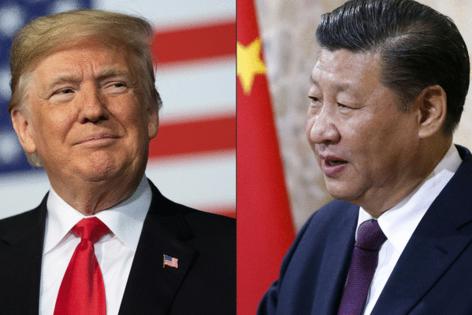Trump says call with Xi yielded rare earths progress, more talks
Published in News & Features
WASHINGTON — President Donald Trump and Chinese President Xi Jinping agreed to further trade talks and the American leader said they cleared up disputes surrounding rare earth exports at the heart of tensions between the world’s two largest economies.
Trump acknowledged Thursday the trade relationship with China had gotten “a little off track” but said now “we’re in very good shape with China and the trade deal.” He posted earlier on social media that there “should no longer be any questions respecting the complexity of Rare Earth products.”
“We we’re straightening out some of the points, having to do mostly with rare earth magnets and some other things,” the president later told reporters in the Oval Office.
Stocks rose as investors hoped the discussion would calm the dispute. The S&P 500 erased losses as Trump posted that the call was “very good” and “resulted in a very positive conclusion for both Countries.” The Bloomberg dollar spot index pared its earlier declines.
But the U.S. president did not specify whether Beijing had agreed to speed export licenses on magnets crucial to a wide range of critical American products. Questions also remained about what, if anything, Trump conceded to Xi.
The Chinese leader said Beijing had complied with the terms of tariff truce struck by the two nations last month in Geneva, according to a readout from China’s Foreign Ministry, even as U.S. officials have complained that export controls on rare earths have not been lifted quickly enough.
China’s statement said that Trump told Xi Chinese students are welcome to study in the United States. The president’s administration has taken steps to block foreigners from obtaining visas to study at U.S. universities.
“Chinese students are coming. No problem. No problem. It’s our honor to have them,” Trump told reporters.
The additional negotiations, Trump said, would occur “shortly” and include U.S. Treasury Secretary Scott Bessent, Commerce Secretary Howard Lutnick and U.S. Trade Representative Jamieson Greer.
Trump said the 1 1/2-hour conversation was focused almost entirely on trade, though the Chinese readout suggested Xi had cautioned Trump on Taiwan after reports the U.S. was stepping up arms shipments there.
China also struck a more combative tone on trade, with its readout saying Xi urged Trump to remove “negative” measures that have roiled ties.
Xi also said the countries should work to reduce misunderstandings and that Trump was welcome to visit China, according to the readout. Trump posted he “reciprocated” with an invitation for Xi to visit the U.S. and later said he would travel to China with first lady Melania Trump, but did not say when.
Relations between the two rivals have soured in recent weeks, with both sides accusing the other of violating a trade truce that brought down tariffs from massive highs.
The Chinese Foreign Ministry said earlier the call was initiated at Trump’s request.
With the fresh conflict threatening the fragile détente, market analysts were hopeful the conversation would pave the way to a trade off-ramp.
The phone call between the leaders marks their first known formal contact since Trump took office. The last conversation between Trump and Xi took place in January before the U.S. president’s inauguration.
Rare earths have emerged in recent days as a key flashpoint. The U.S. has accused China of reneging on a promise to relax export controls on such metals needed for cutting-edge electronics. Beijing has been frustrated by fresh U.S. restrictions on the sale of chip design software and plans to start revoking visas for Chinese students.
Trump has long said direct talks with Xi were the only way to resolve differences between the nations, but the Chinese leader had thus far been reluctant to get on the phone with his American counterpart — preferring that advisers negotiate key issues.
Tension Points
Export controls and U.S. actions on student visas and technology curbs will likely be central to future negotiations. U.S. and Chinese trade chiefs only agreed in Geneva last month to lower tariffs for 90 days, as they worked toward a broader deal.
History suggests that any final deal could be a long time coming. In 2018 during Trump’s first term as president, the two sides agreed to put their dispute “on hold” after a round of negotiations, but the U.S. soon backed away from that deal, leading to more than 18 months of further tariffs and talks before the signing of the “Phase One” deal in January 2020.
One goal for China this time around will be seeking relief from U.S. export controls on cutting-edge chips vital for AI and military advancement. That’s likely to be a sticking point in Washington, with both Democrats and Republicans in rare agreement that Beijing poses a national security threat.
Beyond strains in economic ties, geopolitical frictions are also growing. Foreign Ministry officials this month protested U.S. Defense Secretary Pete Hegseth’s assertion at a gathering of military chiefs in Singapore that China poses an imminent threat to Taiwan, a self-ruled island claimed by Beijing.
_____
(With assistance from Josh Xiao, Alan Wong, Colum Murphy and George Lei.)
©2025 Bloomberg L.P. Visit bloomberg.com. Distributed by Tribune Content Agency, LLC.







Comments